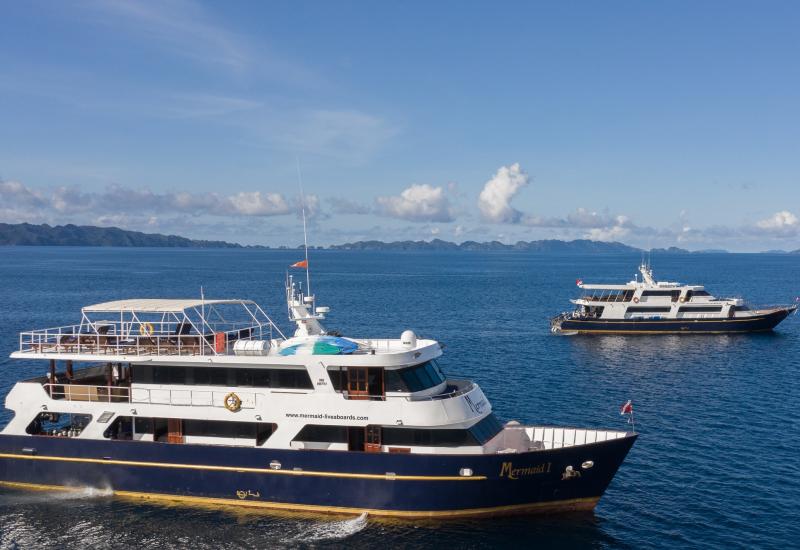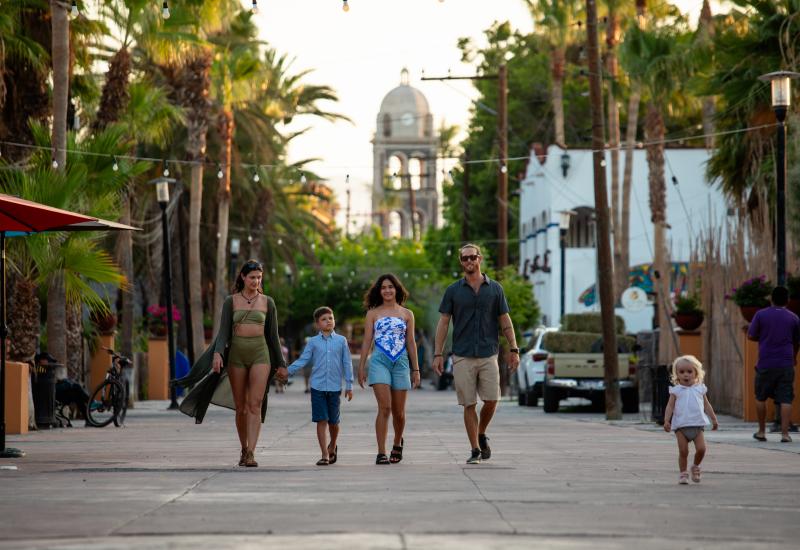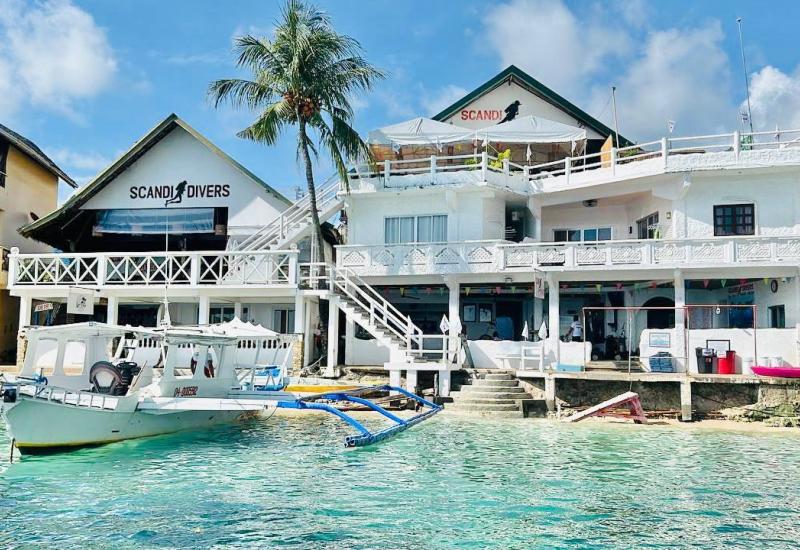Fiji Travel Guide (2002)
 A diver examines patches of sinularia coral on the Three A's site in the Yasawa group.
A diver examines patches of sinularia coral on the Three A's site in the Yasawa group.
November 2002
By J.C. Gamble
The airport resonated with a serenade, strummed by Fijians with ukuleles and guitars, with the verse "bula, ni sa bula," which means "good morning and good health." Bula is the universal Fijian greeting. After a few days diving in this tropical land, I found myself saying it to everyone from divemasters and fellow travelers to village children.
"Bula," the children would say shyly and then gawk.
"Booolah," I'd reply and they'd erupt in laughter.
It's the sort of phrase that lets you know, from the minute you step into the humid airport to claim your dive gear, that you are among the friendliest people in the Pacific, if not the world.
Captain William Bligh, marooned at sea in 1789 with 18 crew members barely two weeks after Fletcher Christian seized the HMS Bounty, saw the Fijians a bit differently. They pursued him doggedly with war canoes in the Yasawa Group. He nearly lost several men to the cannibalistic paddlers during his desperate 1,800-mile flight to Timor through the shallow reef-studded waters north of Viti Levu that now bear his name. If he'd traveled with a stash of kava, he might have received a less bloodthirsty welcome.
Draining the Bilo
 The sacred tanoa, centerpiece of any kava ceremony.
The hand-carved tanoa bowl looks like a wooden turtle shell turned upright. Across the grass, Yasawa I Ra Ra's village elders, all tan-skinned men bedecked in grass leaves, sulu skirts and frangipani necklaces, sit in a closed circle with a pair of guitars. One pours fresh water into the bowl, squeezes a burlap sack stuffed with pulverized kava root (or yanqona) and dips a half coconut methodically in the earthen cocktail. The bowl's water muddies and they begin chanting.
The sacred tanoa, centerpiece of any kava ceremony.
The hand-carved tanoa bowl looks like a wooden turtle shell turned upright. Across the grass, Yasawa I Ra Ra's village elders, all tan-skinned men bedecked in grass leaves, sulu skirts and frangipani necklaces, sit in a closed circle with a pair of guitars. One pours fresh water into the bowl, squeezes a burlap sack stuffed with pulverized kava root (or yanqona) and dips a half coconut methodically in the earthen cocktail. The bowl's water muddies and they begin chanting.
Between the rotu, or chief of the village, and myself, a symbolic rotu elected by our live-aboard group, lies a polished cowrie shell, anchored to the sacred bowl by a two-foot hemp strand. We are enacting an ancient tribal greeting, cemented by imbibing kava, a licorice-like brown water distilled from roots of the yanqona pepper plant. In years past, anyone who crossed the cowrie shell between tribal rotus was flogged to death with hand axes.
Alfie Niubalavu (seven feet tall, his name means "long coconut" in English), a Fijian and cruise director of our ship the Yasawa Princess, had given specific instructions about the kava ceremony and village protocol. I recall his instructions: "Clap, say 'bula,' drain the bilo shell and clap twice." Earlier that week, he'd transformed my fairway golf clap into the hollow clap I'd seen once in a surf movie kava scene. The rotu's clap must carry a presence, he warned, and command respect from the village men. A little too eager, I hoist the shell, filled to the brim or high tide, and a rivulet of kava trickles down my neck.
"Slow, slow, Rotu Joe," Alfie cautions. My clap resonates. The village chief ignores the spill and heads back for a refill.
There will be no flogging.
|
 The post-kava stick dance of Yasawa I Ra Ra.
The post-kava stick dance of Yasawa I Ra Ra.
Kava Narcosis
 Like fields of poppies, dendronephthya octocorals and gorgonians carpet Fiji's reefs.
Nitrogen narcosis is a bit like a heady kava buzz, a dulling of awareness that leaves you slow-witted. In the Fiji islands, divers spend time with locals and invariably imbibe kava, or grog as it's called in the islands. Depending on potency, it produces either disgust or, if you can stomach it, a mellow state that makes you want to sing songs, smile, laugh a bit and maybe strum a six string.
Like fields of poppies, dendronephthya octocorals and gorgonians carpet Fiji's reefs.
Nitrogen narcosis is a bit like a heady kava buzz, a dulling of awareness that leaves you slow-witted. In the Fiji islands, divers spend time with locals and invariably imbibe kava, or grog as it's called in the islands. Depending on potency, it produces either disgust or, if you can stomach it, a mellow state that makes you want to sing songs, smile, laugh a bit and maybe strum a six string.
Slightly bleary from my night of social drinking, I make the transition from kava hangover to dive boat to blue water with surprising ease. There is a realization any diver makes once immersed -- there is more to Fiji's reefs than the supple dendronephthya coral for which it has long been associated.
Just as the individual islands--the Yasawas, the Lau Group, the Mamanucas, Kadavu, Taveuni and the Lomaivitis--each have separate villages with their own endemic ceremonies, so do the dive sites of each group have their own hallmark.
The bommies offshore in the outer islands of the Lomaiviti group are known for pelagics drawn to their shoals of baitfish. Walls of thriving snowy soft coral are the norm on Vanua Levu's eastern shore and on Taveuni and Matagi. Acres of plate and staghorn corals have colonized the Yasawas and Mamanucas. Depending on where you land, it's all a bit different and equally memorable.
The islands and coral gardens that comprise the nation of Fiji number over 330 at low tide and less than 300 at high tide. Fijians joke about this fact, opting to cite the higher number. Draw a circle around the islands, extend it from Kadavu in the south to Rotuma in the north, and you have far more water than land, clear water that is forever shifting over fields of vivid soft coral. Their proximity to the Great Tongan Trench, a deepwater canyon between the islands and Tonga, and the island's volcanic heritage are responsible for the nutrient-laden waters that sustain the reef world.
Three A's
North of the Bligh Waters, the 21 volcanic islands of the Yasawa group sit aligned in arrow formation off Viti Levu's northwest coast and are among the most pristine hard coral reefs in Fiji. They were made famous in 1980's Blue Lagoon, in which a scantily clad Brooke Shields and Christopher Atkins lived and swam in an Eden-like paradise. When the script reads "Location: deserted white sand beach," Hollywood directors come to Fiji. The majority of Castaway was shot in the Mamanucas, while the psychedelic dream scene in Contact was filmed near Turtle Island in the Yasawas.
Cruise ships, a few backpacker bure encampments and a super-exclusive $1,000-a-day resort thrown in for good measure are serviced by ferries and float planes out of Lautoka. They comprise the only foreign traffic here in the Yasawas. Forget about dive boats, much less about the names of the sites. These are uncharted reefs and without GPS coordinates, a dive boat captain would be hard-pressed to dial in a site repeatedly. Just ask Lance Millar, owner of the Tavewa-based Westside Watersports, how the sites were named.
"We had these three guys from Sweden on board and they knew everything about everything and were total #$%holes," says Millar as he steers the Aftershock, a dive boat appropriately named judging by its twin 250s. "So we named this site the Three A's ... the three amigos."
East of Nacula Island, the Three A's, like most of the Yasawas' dive sites, is a hard coral site with healthy acropora corals and the occasional pods of blooming soft corals. A dive slate for note-taking is useful for the simple reason that Yasawas' diving merits barely a passing reference in most guidebooks.
But rest assured, there is much to occupy one's attention: baby whitetip sharks, humphead bannerfish, spotted sweetlips, wahoo, Midas blennies, Moorish idols, Chinese groupers and twotone dartfish all captivate divers. There's an air of discovery each time you backroll into the triple-digit vis of this remote corridor. On the way to a site at high tide, I look out on foaming waves barreling into a reef and overhear Millar.
"I didn't know that was there before," he says, and we steer for a closer look, readying our tanks.
Isa Lei
 Around one-third of Fiji's 3,000-plus plant species are endemic to the islands.
For those of us aboard the Yasawa Princess live-aboard, our last dive day in Fiji comes too soon. It is the type of sendoff old friends give when you relocate to a new town. We dine on a lovo dinner, share a final kava ceremony and listen as the crew belts Fijian standards, among them the plaintive farewell "isa lei."
Around one-third of Fiji's 3,000-plus plant species are endemic to the islands.
For those of us aboard the Yasawa Princess live-aboard, our last dive day in Fiji comes too soon. It is the type of sendoff old friends give when you relocate to a new town. We dine on a lovo dinner, share a final kava ceremony and listen as the crew belts Fijian standards, among them the plaintive farewell "isa lei."
In the distance, I can hear the clang of a steel shaft being driven into a mortar, pulverizing the yanqona roots to powder. The Southern Cross constellation beams out over the protected waters of Tavewa and Nanuya Lai Lai where the boat lies at anchor. We sit cross-legged before the tanoa. It's considered rude to leave the kava circle before the great chalice is drained so John Purves, Westside Watersports' divemaster, and I stay until traces of the sun poke over the horizon.
"Time for a washdown," Purves says. I'm a bit confused as to his meaning after 14 bowls of the opaque mud water. I'm a bit confused in general. "You know, a beer to cleanse the taste of the kava."
Anything to rid that aftertaste.
The "Real Fiji Kava"
Americans have a reputation for converting souvenir tanoas into salad bowls once back across the date line. Strolling down main street in Nadi, I was on the hunt for a nice traditional bowl.
After much haggling, an Indian woman in the local market parted with a wooden tanoa for $20. At nearby Jack's, Nadi's Kmart-like department store of tourist wares, I found pre-packaged "Real Fiji Kava" for a few bucks, an easy stash in the carry-on luggage.
I envision a backyard kava ceremony to be enacted once home in the states. My dive buddies and colleagues will arrive to find me dressed in a cloth skirt, playing guitar around a wooden bowl, eager to share a coconut shell of mucky water.
"Bula," I'll say. "Ni sa bula."
A Shark Encounter Unlike Any Other
Joelie Cagilaba's eyes went white, his grip on my left arm tightened and I knew there was a large shark somewhere behind me. Standing upright in the arena at 90 feet, I wanted to get in the fray for the sake of a photograph and Joelie was eager to oblige. Most divers were flush tight against a dead coral wall, shoulder to shoulder like trench-bound soldiers, awaiting the charge of schooling sharks and jack crevalles to the fish-filled trash can.
I swung around and managed one shot of the 14-foot bull, a female the size of a microbus, cruising in for a look-see at the daily Aqua-Trek 3D shark feed at Shark Reef off Pacific Harbour in southern Fiji. Joelie's right hand was tight to a hooked steel cane some apostle would use when the shark, uninterested in the chaos, headed up the coast.
There is more to the Shark Reef dive than big bull sharks. This is one of the most unique shark-feeds on the planet because of the multitude of species drawn in by the daily arrival of 200 kilos of fish entrails from the Suva fish factories. Whitetips, blacktips, gray reefs, nurse sharks, bull sharks and lemons are consistent entertainers with the occasional visit by a silky, tiger or great hammerhead.
"Normally, you'd have to do several shark dives around the world to see this many sharks," says Brandon Paige of Aqua-Trek, the operation that created the dive three years ago.
Dive In: Fiji
LOCATION: Fiji lies in the southwestern Pacific, 1,750 miles northeast of Sydney, Australia. The 333 islands of the archipelago are arranged over 80,000 square miles of ocean. The islands of Viti Levu, Vanua Levu and Taveuni make up 90 percent of the nation's landmass and are home to 85 percent of the nation's population of 750,000.
GETTING THERE AND AROUND: The national carrier Air Pacific, Qantas and Air New Zealand fly three weekly nonstop flights from Los Angeles to Nadi. The flight takes seven to eight hours. Inter-island flights are available on Air Fiji, Sunflower Air, Turtle Airways and Air Wakaya.
DOCUMENTS: U.S. and Canadian citizens will need a passport valid for more than three months from their date of entry and return ticket. You will have to pay a F$20 departure tax.
CULTURE: Fijians are a modest people, and outside the resorts, you should avoid wearing anything that shows too much leg. When visiting a village or attending a church service, women must wear long pants and men are often encouraged to follow suit.
DIVE OPERATIONS: There are more than 50 dive operators and about six live-aboards currently serving Fiji. Live-aboards ply the bommies and offshore sites that see little diving pressure.
FIJI DIVE SAVVY: Pack a safety sausage in your dive bag--this is current country with serious tidal changes. A dive light is a must to fully appreciate the kaleidoscope of soft corals.
CLIMATE: June through October is perhaps the best time to visit--it's drier, cooler and far less humid than the rest of the year. It's also the time when underwater visibility is at its peak. Air temperatures range from 68F to 73F and water temps can drop to 75F. If you're prone to cold, you'll need at least a 3mm wetsuit; some divers even wear 5 to 6 mm suits with hoods. On the other hand, December through March is the rainy season, when temperatures range from 73F to 86F, and water temps can climb into the low 80Fs.
MONEY: The Fijian dollar (F$) is the local currency and at press time $1 was worth F$2.12. Credit cards are accepted at larger hotels and resorts. There are banks in all the towns, but it might not be possible to exchange traveler's checks on remote outer islands. Tipping is not expected and is, in fact, discouraged in some resorts.
HEALTH CONCERNS: Fiji is free of most tropical diseases. However, travelers may want to exercise caution in outlying areas. Tap water is generally safe to drink in all cities, resorts and urban areas. There is a hospital and recompression chamber.
TIME: Fiji is 20 hours ahead of Los Angeles, 17 hours ahead of New York.
ELECTRICITY: 240 volts, with three-pronged Australian-type outlets. Some resorts and live-aboards supply 110 voltage or provide converters.
FOR MORE INFORMATION: Contact the Fiji Visitors Bureau at (800) YEA-FIJI or visit its web site at www.bulafiji.com or www.bulafijiamericas.com.
A Fiji Dive Site Sampler
1) GREAT WHITE WALL AT SOMOSOMO STRAIT. Sites in the Somosomo Strait are some of the finest soft coral diving in the Pacific, accessible from both Vanua Levu and Taveuni Island. White soft corals cover the wall from 75 to 220 feet. DEPTH: 40 to 130 feet. CURRENT: Moderate to strong. SKILL: Intermediate.
2) SIDE STREETS AND FANTASY AT BEQA LAGOON. Coral bommies and overhangs laced with tunnels and caves characterize these dives in this southern lagoon off Viti Levu. You'll find huge sea fans and feather stars as well as lionfish, batfish and schooling horseye jacks. DEPTH: 20 to 60 feet. CURRENT: Light. SKILL: Novice.
3) GREAT ASTROLABE REEF AT KADAVU. Along Kadavu's northern rim, the Astrolabe barrier reef has several sites. Reefs, large walls and ravines, are populated with tiera batfish, Maori wrasse, flame hawkfish, citrus gobies, canary blennies and the occasional rainbow runner, yellowfin tuna and wahoo. DEPTH: 30 to 90 feet. CURRENT: Light. SKILL: Novice to intermediate.
4) MAGIC MOUNTAIN OFF NAMENA. Dendronephthya soft corals flank this pinnacle, 80 feet in diameter, that ascends to within 10 feet of the surface. Jacks preying on bait clusters are a common sight. LOCATION: Outer islands of Namena. DEPTH: 10 to 120 feet. CURRENT: Light. SKILL: Novice.
5) E-6 IN THE LOMAIVITIS BETWEEN VITI LEVU AND VANUA LEVU. A favorite of live-aboards, this pinnacle, complete with its own cave swim-through, rises from 3,000 feet. It's a magnet for sea life, including sharks, rays and other pelagics, and a must-dive for underwater photographers for whom the site is named. DEPTH: 30 to 130 feet. CURRENT: Light. SKILL: Beginner.
6) THE W AND 7) THE PINNACLE IN THE MAMANUCA ISLANDS. Named for their shapes under water, the W and Pinnacle are just a 30-minute boat ride from resorts in this 11-island group. Chevron barracuda schools, whitetip sharks and even mantas are found on the periphery, while porcelain crabs and nubibranchs hide in the table coral's recesses. DEPTH: 40 to 100 feet. CURRENT: Light. SKILL: Novice.










